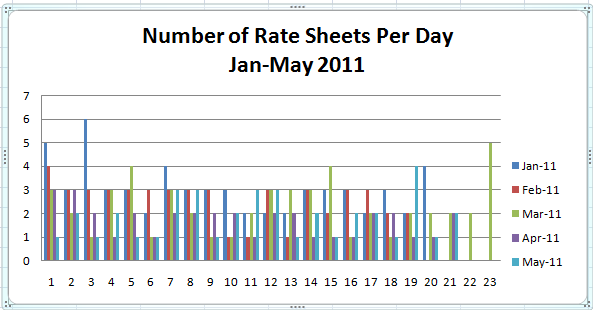Thanks for stopping by - This is a work in progress, so please feel free to jump in with me - any comments, feedback, or participation in the conversation is encouraged! You might want to want to sign up for email updates on the right, or subscribe to my RSS feed. Thanks for visiting!
Glad to have you back - have you considered signing up for email updates on the right, or subscribing to my RSS feed? Thanks for visiting!
One of the reasons it can be difficult annoying to shop for mortgage is because the undulating marketplace for interest rates can lead you to conflicting feedback from different providers. Banks issue loan rate pricing each morning, but often adjust mid-day when the bond market is moving one way or the other. And just as can happen in the bond markets, interest rates can get on a run up, a run down, or a choppy sideways pattern that looks like your neighbor’s kid on a pogo stick passing by the kitchen window.

Rates changed 39 times during the 21 bond trading days in May.
That can really make it a pain in the neck to figure out what the best rate is going to be when you’re in the middle of buying or refinancing a home. You call one lender first thing in the morning, email two others at lunch, one of whom doesn’t reply until the end of the day, and by the time you have all your research, you’re looking at three different ‘vintages’ of rate quote. Can a fair comparison be made?
Maybe.
But you’ll need to know first if rates have changed over the course of the day. And based on recent history, odds are you’ll be comparing apples and gooseberries. Besides, even if you can get three quotes in the same window, how do you know if today is better than tomorrow?
When it comes to mortgage quotes, the little differences can be meaningful. If you want to maximize your shopping results, you need to make sure you are comparing quotes from the same vintage, and you need to know what vintage is produced in the best climate.
Rates changed every 3.76 hours in May
In Maythere were 21 bond trading days. We received 39 rate sheets over those 21 days, or an average 1.86 rate sheets per day.
Most lenders have open lock desks for 8 hours a day. Some are open for 9, and the most aggressive lenders, often the most sensitive to bond market fluctuation, accept rate locks for about 6 or 6 1/2 hours a day. On turbulent bond market days, they often delay the first rate sheet release.
Assuming an average of 7 hours for an open lock desk, and 1.86 rate sheets per day, that means rates changed every 3.76 hours. Compared to January’s average expiration of 2.29 hours, the volatility has fallen significantly in recent months.
Intra-day Mortgage Rate Volatility Doesn’t Tell You Everything
While volatility was pretty steady month over month from April to May, the direction of rates in general was lower. Other than one brief increase, rates trended downward, steadily, all month. The conviction of the move likely had much to do with lower volatility.
Even still, with rates lasting less than 4 hours on average, it still makes it difficult to do your comparison shopping.
How to Make the Most of it
Last month, rates changed 39 times on 21 bond trading days. If a typical escrow period when you’re buying a new home is 30 days, that means you had a 1 in 39 chance to nail it on your rate lock. If you’re qualified to be applying for a mortgage, it’s a virtual certainty that you already have a full time job, so you really should rely on a professional with the time and insight to be able to monitor this for you.
If you speak to someone who suggests they can get you the perfect lock, that’s probably a bad sign. Market prediction on that level is impossible. Similarly, you shouldn’t expect to catch the market at it’s absolute low – it’s not a realistic expectation. But a professional who can explain the market context you’re transacting in, and show you which calendared events have potential to introduce risk or opportunity to your strategy, is probably more valuable as a resource than anything else when trying to maximize your rate lock.
Make sure you get your rate quotes in the same vintage. This means that any lender who isn’t quick to reply to your inquiry isn’t really helping out. Then, make sure your lender is tuned in to the economic calendar, so that you can be aware of what days are more or less likely to be volatile ones. The market gets little economic data points or events to digest just about every day. It’s important to know which ones carry greater risk at any given time, as their significance can change with the greater context of the marketplace. The last thing you want to do is leave your rate lock open when the risk is greater than the potential reward.
Working with your lender to create a lock and pricing strategy suitable for your transaction will probably shed some light on who you’re working with, and serve you far better in the long run than comparing apples and gooseberries.
Need help with a rate lock strategy? Contact me below and tell me how I can help.